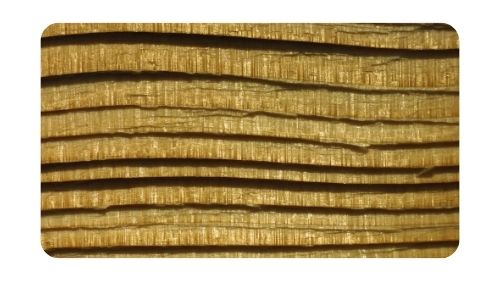Douglas fir is well-known for its use in outdoor construction and building work. And this is all thanks to this lumbers incredibly high resistance to decay.
But, while raw Douglas fir wood can shrug off a bit of rain, that does not mean it can handle a downpour of very wet conditions.
If you were to submerge this timber in the ground… the moisture in the soil would rot away a Douglas fir board in roughly 3 to 6 years.
So, any outdoor Douglas fir construction, (such as siding, fencing, and decking), all need to be treated to help them hold up against a deluge of rainwater.
So, what is the best treatment for a Douglas fir porch decking?
If that porch has been made out of pressure treated Douglas fir, then you should seal it with an exterior wood sealer. The pressure treatment process will infuse Douglas fir with chemicals that help to protect it from rot, insects and decay. However, this durable timber will still need a waterproofing sealer to help it repel rainwater, moisture, and humidity.
Related Post: How To Dry Pressure Treated Wood (Quickly And Without Warping)
Now, ideally, your sealer will be the type of product that really sinks deep into wood. Why? Well, when it comes to decking, having a sealant that simply nestles on the surface won’t provide enough protection.
So, what kind of sealant should you be on the look out for? And what if you’ve made a porch made out of untreated Douglas fir? Will a good quality sealant still be good enough?

This post may contain affiliate links to products that we receive a commission for (at no additional cost to you). Learn more here.
So, Is Douglas Fir Good For Decking?
Absolutely! This softwood is one of the most weather-resistant lumbers on the market. And that’s because this wood type barely shrinks or warps if moisture gets into it.
Besides the risk of decay, wood warping is one of the main reasons as to why we try to prevent moisture from getting into wood.
You see, when moisture gets into wood, it causes wood fibers to expand and swell like a sponge. And as the wood dries – and the water evaporates – the wood shrinks back into place.
This movement creates a problem called ‘warping’.

Related Post: What To Do When Solid Wood Cabinet Doors Start Warping (Solved!)
Now, Douglas fir is special in this regard, in that this particular timber barely moves if moisture gets into it. It is what we like to refer to in the industry as a ‘stable’ wood. This is because once this wood has been seasoned, it barely warps and hardly moves around afterward.
Related Post: How To Season Wood (7 Tips)
This stability makes it ideal for outdoor building construction work, like decking, since a bit of damp or humidity will hardly give Douglas fir a problem.
Can Douglas Fir Be Pressure Treated? Yes, Douglas fir can be treated to help prevent rot and decay from setting in.
How Long Does A Douglas Fir Deck Last Exactly?
If treated and sealed, a Douglas fir deck can last up to 50 years. That’s, of course, provided that you maintain and retreat the deck once a year or so.
If the deck is made from untreated Douglas fir, it won’t last as long. But it will still hold up for a good 10-15 years all the same.
So You Really Can Use Untreated Douglas Fir Outside?
If it is untreated bare Douglas fir, (and you’ve applied no penetrating sealer to it), then no you can’t.
Douglas Fir is a top pick if you’re looking for wood to use on an outdoor project. In fact, manufacturers use Douglas Fir to make exterior grade plywood sheets because it is surprisingly durable when exposed to the great outdoors.
To be clear, you certainly could make your decking out of it… provided you accept the fact that your decking won’t last beyond a year or two.
Now, if you are talking about Douglas fir that hasn’t been pressure treated – but has been coated with sealer – then yes you can.
How Do I Waterproof And Protect My Douglas Fir Deck Outside?
The answer to this is pretty simple… you apply a deep penetrating sealer. Ideally something that also offers some level of UV protection from sunlight too.
For example, if you’re looking to give your decking a sleek finish, you might have thought of going with an oil finish like Teak oil.
Teak oil can be applied to Douglas fir as a wood preservative. It will sink down into wood fibers, making them less prone to absorbing water.
And some Teak oil products can even contain UV inhibitors, which protect wood from UV-damage. However, as an exterior wood sealer, Teak oil is not a first-choice outdoor wood finish.
So what should you use instead?…
Related Post: Don’t Put Teak Oil On Douglas Fir (Use This Instead)
Waterproofing Douglas Fir With Oil-Based Sealer
These sealers will sink into Douglas fir wood more than a water-based sealer. This allows them to leave less of a film on the surface of decking. This is great if you want that wooden deck to look as rustic and natural as possible.
But, they take much, much longer to dry than water based sealers. Which can be a problem if you live in an area that rains frequently.
And although these sealers may only take a couple hours to dry to the touch, but they can take weeks to fully cure.
What Is The Difference Between ‘Dry’ and ‘Cured’: A wood sealer is deemed dry when it turns from a liquid and sets into a soft film. However, a sealer is cured when it turns from a soft film into a hard, scratch-resistant durable resin.
Still, oil-based sealers are more durable than their water-based cousins. And a quality oil-based sealer, such as Rust-Oleum’s Oil-Based Ultimate Spar Urethane will keep your Douglas fir decking dry for up to 5 years.
Available in Gloss, Semi-gloss, and Satin, this product offers UV protection, guards against weathering, and prevents your deck from getting scratches and scuff marks too.
You can find the latest prices for for this oil-based sealer over on Amazon.
Waterproofing Douglas Fir With Water-Based Sealer
The advantage of water-based sealers lies in speed; these sealants dry and cure faster than oil-based sealers.
Another advantage is the fact that water-based sealers dry clear. While oil-based sealers have a bit of a honey-hue to them once dry.
But, water-based sealers don’t sink into wood as deep. Instead, they prefer to sit and build up most of their film on the surface of the deck. As a result, they tend not to offer as much in-depth protection compared to oil-based sealers.
Which is why if you opt for a water-based sealer, make sure you use one that actively works towards protecting wood both inside and out.
It is why Seal-Once Marines Water-Based Penetrating Wood Sealer is so great for outdoor decking.
This particular water-based sealing product uses nano-particle technology to sink into wood just as deep as oil can. And it will coat your deck with a waterproof coat that let’s water vapor out… but no moisture back in.
You can check out the latest prices for Seal-One Sealer over on Amazon.
So To Sum Up…
The best treatment for a Douglas fir deck, (pressure treated or not), will always involve a sealant of some kind.
But, just a quick heads up, no matter which sealer type you go for, be sure you stick to it for the lifetime of your deck.
Which means that if you’ve used an oil-based sealer, then continue to use an oil-based sealer when its time to reseal it. And vice-versa with a water-based sealer.
Oil and water don’t mix, and this is none more so true than when it comes to restoring/resealing decking.
It doesn’t matter if you’ve done all you can to remove leftover old sealant from the deck. Always stick to the golden rule; reseal oil with oil, and water with water.
